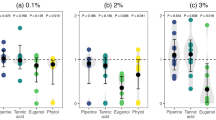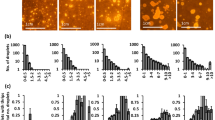Abstract
Extracts of volatiles from foliage of three plants in the Apiaceae, Conium maculatumL. (hemlock), Coriandrum sativum L. (coriander), and Petroselinum crispum Mill. (Nym.) (parsley), previously shown to exhibit antifeedant activity in assays with the field slug, Deroceras reticulatum (Muller) (Limacidae: Pulmonata), were studied further to identify the active components. Coupled gas chromatography–mass spectrometry (GC–MS) and neurophysiological assays using tentacle nerve preparations resulted in the identification of 11 active compounds from the three extracts. Wheat flour feeding bioassays were used toDetermine which of these compounds had the highest antifeedant activity. One of the most active compounds was the alkaloid γ-coniceine, from C. maculatum. The role of potentially toxic alkaloids as semiochemicals and the potential for using such compounds as crop protection agents to prevent slug feeding damage is discussed.
Similar content being viewed by others
References
Airey, W. J., Henderson, I. F., Pickett, J. A., Scott, G. C., Stephenson, J. W., and Woodcock, C. M. 1989. Novel chemical approaches to mollusc control, pp. 301–307, in I. F. Henderson (ed.). Slugs and Snails in World Agriculture, BCPC Monograph No. 41, Thornton Heath, UK.
Bernays, E. A. and Chapman, R. F. 1994. Host-Plant Selection by Phytophagous Insects. Chapman & Hall, London.
Bettolo, G. B. M. 1983. The role of natural plant products in plant-insect and plant-fungi interactions, pp. 187–222, in D. L. Whitehead and W. S. Bowers (eds.). Natural Products for Innovative Pest Management. Pergamon, Oxford.
Chase, R. 1981. Electrical responses of a snail tentacle ganglion to stimulation of the epithelium to wind and odours. Comp. Biochem. Physiol. 70A:149–155.
Chase, R. 1982. The olfactory sensitivity of snails, Achatina fulica. J. Comp. Physiol. 148A:125–136.
Chase, R. and Croll, R. P. 1981. Tentacular function in snail olfactory orientation. j. comp. physiol. 148:225–235.
Clark, S. J., Dodds, C. J., Henderson, I. F., and Martin, A. F. 1997. A bioassay for the screening of materials influencing feeding behavior in the field slug deroceras reticulatum (Muller). Ann. Appl. Biol. 130:379–385.
Craveiro, A. A., Matos, F. J. A., Alencar, J. W., and Plumel, m. m. 1989. Microwave oven extraction of anEssential oil. flav. frag. j. 4:43–44.
Dawson, G. W., Henderson, I. F., Martin, A. P., and Pye, B. J. 1996. Physiochemical barriers as plant protectants against slugs (Gastropoda, Pulmonata), pp. 439–444, in I. F. Henderson (ed.) Slug and Snail Pests in Agriculture, BCPC Proceedings No. 66. BCPC, Farnham, UK.
Dodds, C. J. 1996. The control of slug damage using plant-derived repellents and antifeedants, pp. 335–340, in I. F. Henderson (ed.) Slug and Snail Pests in Agriculture, BCPC Proceedings No. 66. BCPC, Farnham, UK.
Dodds, C. J. 1997. The Action of Semiochemicals on Feeding Behavior and Neurophysiology of the Field Slug, Deroceras reticulatum (Muller). PhD Dissertation, University of Portsmouth, Portsmouth, UK.
Dodds, C. J., Henderson, I. F., Watson, P., and Leake, L. D. 1999. Action of extracts of Apiaceae on feeding behavior and neurophysiology of the field slug, Deroceras retculatum. J. Chem. Ecol. 25:2127–2145.
Dodds, C. J., Ford, M. G., Henderson, I. F., Leake, L. D., Martin, A. P., Pickett, J. A., Wadhams, L. J., and Watson, P. 1996. Slug chemical ecology: Electrophysiological and behavioral studies, pp. 73–81, in I. F. Henderson (ed.) Slug and Snail Pests in Agriculture, BCPC Proceedings No. 66. BCPC, Farnham, UK.
Fukuda, Y., Matsubara, S., and Utimoto, K. 1991. Palladium-catalysed intramolecular addition of amines to acetylenes. synthesis of cyclic imines. j. org. chem. 56:5812–5816.
Garraway, R., Leake, L. D., Ford, M. G., and Pickett, J. A. 1991. The action of a range of volatile compounds on a tentacular preparation of the field slug, deroceras reticulatum (Muller). Pestic. Sci. 33:240–242.
Garraway, R. 1992. The Action of Semiochemicals on Olfactory Nerve Activity and Behavior of Deroceras reticulatum (Muller). PhD Dissertation, University of Portsmouth, Portsmouth, UK.
Garraway, R., Leake, L. D., Ford, M. G., and Pickett, J. A. 1992. TheDevelopment of a chemoreceptive neurophysiological assay for the field slug deroceras reticulatum(Muller). Pestic. Sci. 34:97–98.
Grundon, M. F. and Reynolds, B. E. 1964. δ 1-Piperideines. J. Chem. Soc. 2445–2450.
Kaissling, K. E. 1986. Chemo-electrical transduction in insect olfactory receptors. Annu. Rev. Neurosci. 9:121–145.
Narwott, J., Harmatha, J., and Bloszyk, E. 1986. Secondary plant metabolites with antifeeding activity and their effects on some stored product insects, in Proceedings of the 4th International Works Conference Stored-Product Protection, tel aviv, Israel.
NIST. 1990. Standard Reference Database (Version 3.0.1). Office of the Standard Reference Database, National Institute of Standards and Technology, Gaitersburg
Pickett, J. A. 1990. Gas chromatography-mass spectrometry in insect pheromone identification: Three extreme cases, pp. 209–309, in A. R. McCaffery and I. D. Wilson (eds.). Chromatography and Isolation of Insect Hormones and Pheromones. Plenum, New York.
Powell, A. L. and Bowen, I. D. 1996. The screening of naturally-occurring compounds for use as seed treatments for the protection of wheat against slug damage, pp. 231–236, in I. F. Henderson (ed.) slug and snail pests in agriculture. bcpc proceedings no. 66. bcpc, farnham, uk.
Stephenson, J. W. 1979. The functioning of the sense organs associated with feeding behavior in Deroceras reticulatum (Muller). J. Moll. Stud. 44:340–343.
Watkins, R., Mosson, H. J., Gurney, J. E., Cowan, D. P., and Edwards, J. P. 1996. Cinnamic acidDerivatives: Novel repellent seed dressings for the protection of winter wheat seeds against slug damage by the field slug, Deroceras reticulatum. Crop Prot. 15:77–83.
Author information
Authors and Affiliations
Rights and permissions
About this article
Cite this article
Birkett, M.A., Dodds, C.J., Henderson, I.F. et al. Antifeedant Compounds from Three Species of Apiaceae Active Against the Field Slug, Deroceras reticulatum (Muller). J Chem Ecol 30, 563–576 (2004). https://doi.org/10.1023/B:JOEC.0000018629.58425.18
Issue Date:
DOI: https://doi.org/10.1023/B:JOEC.0000018629.58425.18




